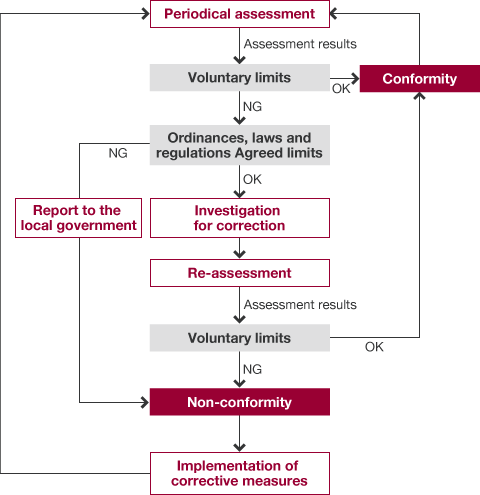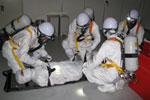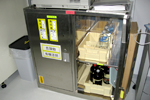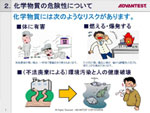 웹 내용 전시
웹 내용 전시

Basic policy for environmental risk management
One of our corporate responsibilities is that we take steps to reduce our environmental footprint while preventing environmental pollution and avoiding other environmental risks. Accordingly, the Advantest Group sets voluntary standards more stringent than prevailing environmental laws and regulations, and implements such standards in the course of operating equipment that could potentially impact the environment, and in monitoring and assessing those operations.
Furthermore, to ensure that we respond without hesitation should an environment-related incident occur, we have forged rules for addressing such risks, stipulated in documented operating procedures and chemical substance emergency-response procedures and other such guidelines, and have put management systems in place related to those rules.
Moreover, our employees and contractors handling particularly high risk operations regularly take part in specialized training and emergency drills, conducted to ensure that they are able to act swiftly in the event of an emergency.
Business location compliance management

Evacuation drills conducted at night

Evacuation drill conducted
during the night
On two separate days, August 8 and August 21, 2012, we performed evacuation drills during the nighttime hours at our Advantest Laboratories facilities and at the Sendai Factory. Whereas we had previously conducted emergency drills exclusively during the daytime, experience with the Great East Japan Earthquake prompted us to also conduct such drills at night to ensure better disaster preparation over different shifts.
In carrying out the drills, we put forward a conceivable scenario involving a power outage in clean room facilities triggered by a major earthquake at night. The drill was performed with the emergency lighting activated, and involved ensuring the safety of employees as they evacuated, combined with operations entailing search and rescue of missing individuals.
Because there is no way of knowing when a natural disaster might strike, Advantest Laboratories and the Sendai Factory will continue performing regular drills to prepare for such contingencies, and will improve protocols for ensuring that employees are able to evacuate swiftly and safely.
The Advantest Group experienced no accidents or related grievances during fiscal 2012.
Basic policy for chemical substance management
We are working to ensure safety management and compliance with laws and regulations in the use and storage of chemical substances used at business locations at the Advantest Group.
To this end, we have adopted a chemical substance management system. Based on this system, chemical substances are registered, safety reviews are conducted, design that supports input/output control and laws and regulations is adopted, and the material safety data sheets (MSDS) that are necessary for the safe handling of chemical substance have been made available for inspection at any time.
In addition, for strengthened risk management and chemicals substance management, we are constructing a safety training system, and conducting audits and providing guidance through the corporate chemical management division to ensure the safety of stored chemical substances to further enhance our safety control system.
Furthermore, we plan to build up our global management system as we aim to achieve the same level of risk management overseas as in Japan.
Ramping up chemical substance controls -Pursuing higher control precision-

Stringent chemical controls

Controls applied to each
and every container

Materials used in training
on chemical substances
In implementing its systems for ensuring proper management of chemical substances, the Advantest Group applies container-level controls on chemical elements handled in the course of operations. Moreover, we pursue flexible practices in this regard through a process that involves first assigning substances to different control rankings on the basis of control levels required for respective substances under the Pollutant Release and Transfer Registers (PRTR Act), the Poisonous and Deleterious Substances Control Act, the Industrial Safety and Health Act, and other such laws and regulations, and then establishing different control methods for each respective ranking.
Adopting chemical control methods more precisely aligned with potential risks
In fiscal 2012, we further revamped our methods for chemical substance control, thereby embarking on practices entailing ramping up control precision on substances that are extremely hazardous and those that we use in large quantities, while otherwise simplifying controls on substances that pose little potential risk.
General education on chemical substances targeting all employees
Moreover, in combination with the specialized training we have been providing on chemical substance safety, in fiscal 2012 we embarked on an e-learning program via the corporate intranet delivering general training on chemical substances intended for all employees, including those whose jobs normally do not entail handling such materials.
We opted to extend this sort of training to a broader range of employees for a number of reasons. For one, an employee handling even familiar chemical agents could cause an accident or pollute the environment as a result of mishandling. Likewise, misuse even of everyday detergents, adhesives and other such items could result in chemical injury, loss of sight, poisoning or bring about other such grave repercussions. Finally, we extended the training to all employees because we want everyone in the company to gain an understanding of ways in which they can better reduce such risks.
Chemical substance control rankings
| Level | Description | Locked storage | Input/output control | Inventory control |
|---|---|---|---|---|
| 4 | Substances that need to be registered with the government when handled due to their extremely high toxicity and impact on society Examples: narcotics, stimulants | ◯ | ◯ | As per laws and regulations |
| 3 | Substances that need to be reported when lost due to their extremely high toxicity Examples: poisonous and deleterious substances | ◯ | ◯ | Monthly |
| 2 | Combustible, corrosive, or chronically toxic substances Examples: organic solvents, acid, alkali substances | ◯ | ◯ | Semiannually |
| 1 | Substances that pose low threat of hazard yet must be controlled on the basis of significant use and other such rationale Examples: solder, fluorinert, adhesives available on the market, lubricants | – | ◯ | – |


